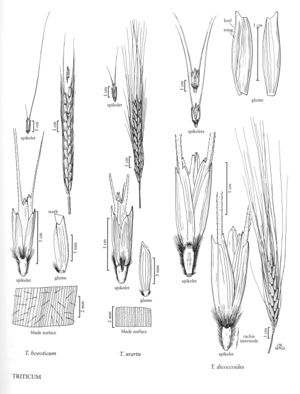Difference between revisions of "Triticum dicoccoides"
FNA>Volume Importer |
FNA>Volume Importer |
(No difference)
| |
Revision as of 19:15, 24 September 2019
Culms to 100 cm, decumbent; nodes glabrous or puberulent; internodes mostly hollow, solid for 1 cm below the spikes. Blades 4-6 mm wide, pubescent. Spikes to 10 cm, wider than thick; rachises densely hairy at the nodes and margins; internodes 3-8 mm; disarticulation spontaneous, dispersal units wedge-shaped. Spikelets 15-25 mm, oblong to rectangular, with 3 florets, usually the lower 2 seed-forming. Glumes 10-15 mm, coriaceous, tightly appressed to the lower florets, 2-keeled, prominent keel winged to the base, 2-toothed, second tooth poorly developed; lemmas 10-15 mm, awned, awns on the lower 2 lemmas to 15 cm, on the third lemma to 2 cm; paleas not splitting at maturity. Endosperm flinty. Haplomes AuB. 2n = 28.
Discussion
Triticum dicoccoides is the wild counterpart of T. dicoccum, and is an ancestor of both T. durum and T. aestivum. Morphologically, it is almost indistinguishable from T. araraticum Jakubz., a wild tetraploid that differs from T. dicoccoides in combining the Ab and G haplomes. Triticum dicoccoides is native to the Fertile Crescent. Its distribution overlaps that of T. araraticum in the northern and eastern portions of the region.
Selected References
None.
